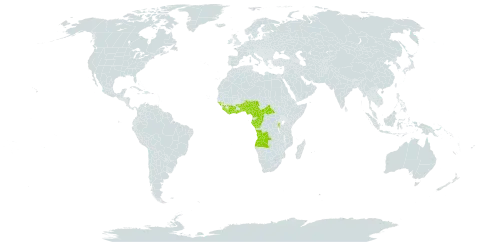Liane 5–10 m. in height or more; plants often drying blackish but sometimes remaining olive-green.. Leaves with a petiole 5–15 mm. long; blade elliptic or broadly obovate, 5–12.5(–16) cm. long, 2–9 cm. wide, shortly acuminate, acute to rounded at the base, with 4–7 pairs of secondary nerves; nervation rather prominently reticulate in the dried state; margin entire or shallowly crenulate in the upper third.. Inflorescence glabrous; bracts ovate, 0.5–1.5 mm. long, acute, entire or minutely dentate, persistent; pedicels 2–5(–7) mm. long.. Buds ovoid, 1.5–2.5 mm. in diameter.. Flowers green or clear greenish yellow, 4–7 mm. in diameter.. Sepals unequal or subequal, suborbicular, ± 1–1.5 mm. long, entire or laxly dentate.. Petals ovate or oblong-elliptic, 2–2.5 mm. long, 1.5–2 mm. wide, not unguiculate, rounded, imbricate at the base, entire or minutely dentate.. Disc deep green, with a granular upper surface, circular in outline, and rather thin in the dried state, 2–2.5 mm. in diameter, with a central depression carrying a slender columnar androgynophore 1–1.5 mm. high.. Stamens 2 mm. long; anthers transversely elliptic.. Ovary pyramid-shaped with a tapering style and trilobed stigma.. Mericarps narrowly oblong, 4.5–6.5 cm. long, 1.5–2.2 cm. wide, acute or obtuse, striate, dehiscent, the valves bearing a distinctive scar 1.5–2.5 mm. long on their internal surfaces (this is a unique character in this group, facilitating positive determination of fruiting material of this species).. Seeds winged, the wing (3–)4–5.5 cm. long, 1.2–1.5 cm. wide; seed coat, marginal nerve and upper part of wing very pale yellowish brown or greyish (not reddish as in most related genera), the coat thickened and cork-like; in each mericarp the 2 tubular placentas joined together and surrounded by a large bilobed structure.. Figs. 10/7, p. 44; 12.
